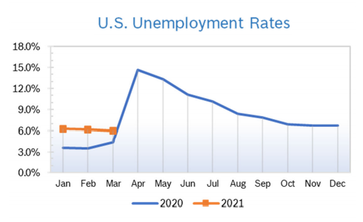|
Concerns about inflation, the possibility that the Fed could increase interest rates earlier than expected and a rapid rise in bond yields triggered a big selloff in tech stocks and sent markets down the last week of the month, despite good earnings and benign inflation numbers. All three indexes nevertheless finished in the black. Consumer Spending Rises 2.4% Consumer spending rebounded sharply in January, rising 2.4% after falling in December. Household income jumped 10% in January as the government delivered stimulus payments of a one-time payout of $600 and an extra $300 a week on top of normal unemployment benefits. It was the second largest increase in income on record, bested only by last April’s increase when the federal government sent the initial round of pandemic relief payments. The personal consumption expenditures (PCE) price index excluding the volatile food and energy component rose 0.3% after a similar gain in December and was up 1.5% year over year. The core PCE price index is the Fed’s preferred measure of inflation for its 2% target. Higher income households have increased their savings, most likely because travel and entertainment have been severely curtailed, causing the savings rate to be historically high. The decline in consumer spending in November and December last year came as virus infections resurged and states and cities ordered additional shutdowns. Consumer spending accounts for 70% of US economic activity. Consumer Prices Rise 0.3% The Consumer Price Index (CPI) rose 0.3% in January after rising a downwardly revised 0.2% in December and was up 1.4% year over year. Core inflation, which excludes the volatile food and energy categories, was unchanged for the second consecutive month and was up 1.4% over the past 12 months, down from a 1.6% year-over-year increase in December. The overall increase was once again driven by a jump in gasoline prices, which rose 7.4% in January after climbing 5.2% in December. Wells Fargo expects inflation to firm up over 2021 as consumer spending rebounds during the second half of the year. Economists think it will be quite some time before inflation returns to a pace consistent with the Fed’s target of 2%. Consumer Confidence Rises to 91.3
Unemployment Falls to 6.2%
Job Openings Rise in December US job openings rose unexpectedly in December to 6.65 million in December after dropping to 6.57 million in November, according to the latest Job Openings and Labor Turnover Survey (JOLTS) from the US Bureau of Labor Statistics (BLS). The increase was led by business services and retail trade, which analysts attributed to companies looking to add workers as the vaccination program rolls out. Separations, which include layoffs and quits, fell to 5.46 million from 5.52 million, and 3.29 million people voluntarily left their jobs, pushing the quits rate up to 2.3%. Wells Fargo notes that at one point job openings were down 31% year over year. Wells Fargo said that due to the relatively small sample size, JOLTS may be painting a distorted picture, as response is coming from stronger businesses that have kept their doors open and are responding to the survey. JOLTS is a lagging indicator, but is closely watched by the Federal Reserve and factors into decisions about interest rates and other measures. Chicago PMI Falls to 59.5 The Chicago Purchasing Managers Index (Chicago PMI) fell to 59.5 in February after rising to 63.8 in January but remained in positive territory for the eighth consecutive month after spending a full year below 50. New Orders dropped 11 points to its lowest level since last August and Production fell more than 9 points after jumping 9.9 points in January. Prices Paid increased for the fifth consecutive month but rose just 0.1 points. Prices Paid remained at the highest level since 2018, with firms reporting higher prices for raw materials, especially tin. The special questions asked how firms coped with the disruption last year and if they were going to require workforce and contingent labor to be vaccinated. The majority, 47%, increased their safety stock; 30% of respondents either diversified suppliers or implemented new technology. A vast majority (87%) had not decided if they would require vaccinations. Looking back to when the series began in 1967, the PMI has ranged from 20.7 in June 1980 to 81.0 in November 1973. Wholesale Prices Rise 1.3% The Producer Price Index (PPI) jumped 1.3% in January after inching up 0.3% in December. The increase was well above expectations and was the largest one-month gain since the index underwent a major overhaul in 2009. The increase was driven primarily by higher costs for energy and services. In the 12 months through January the PPI was up by 1.7%, the largest year-over-year increase in the past twelve months. Core inflation, which excludes the volatile energy and food categories, rose 1.2% in January and was up 2% over the past 12 months. Analysts had expected the trend in inflation to remain subdued for some time but note that there is little sign inflation will rise enough to threaten the economy any time soon. Q4 GDP Growth Revised Up to 4.1% GDP growth for the fourth quarter was revised up slightly to 4.1% from 4.0% first reported, according to the second reading from the Commerce Department. Upward revisions to business investment, state and local government spending and inventory investment were partially offset by a downward revision to personal consumption. Some analysts predict that GDP could contract in the first quarter before beginning to recover as vaccines become more widely available and consumer spending picks up. © Robert Bosch Tool Corporation. All rights reserved, no copying or reproducing is permitted without prior written approval.
Comments are closed.
|
|










